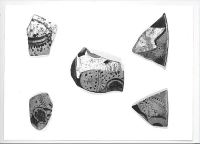



crater
An item at Louvre
Decoration: interior; band (2) under rim; palmette (oblique, frieze, surrounded by, net) on basin; zone (2, separated by, oves) on basin (top, face A and B); gynaeceum scene (2, framed by, column, capital, Doric) on basin (top, face A); woman (cecryphal, aigrette, earring, chiton, himation, seated, on, chair, playing, lyre, decorated with, ribbon); left; woman (bun, draped, holding, arm); woman (chiton, himation, seated, on, chair, in front of, column, Doric); woman (chiton, himation, holding, flute case); right; woman (earring, chiton, himation, holding, casket); woman (cecryphal, aigrette, earring, chiton, himation, holding, bandage); woman (earring, chiton, himation) on basin (top, side B); woman (cecryphal, aigrette, chiton, himation, sitting, on, chair, facing); Eros (headband, frill, offering, crown, leaf, stylized); left; woman (headband, multiple, earring, draped, carrying, basket); right; woman (cecryphal, aigrette, draped, to the right, holding, bandage) on basin (bottom, sides A and B); Dionysian scene (2); maenad (chiton, himation, sitting, on, rock, holding, thyrsus, between); satyr (crouching, dancing) on basin (bottom); meander (including, crosspiece) Condition of the work: entire; chip on edge; highlights erased; foot reattached
Department of Greek, Etruscan and Roman Antiquities
An exhibit at Louvre
The Department of Greek, Etruscan, and Roman Antiquities is home to a collection of artworks representing the Greek, Etruscan, and Roman civilizations; it illustrates the art of a vast area encompassing Greece, Italy, and the whole of the Mediterranean basin, and spans the period from Neolithic times (4th millennium BC) to the 6th century AD.




